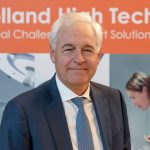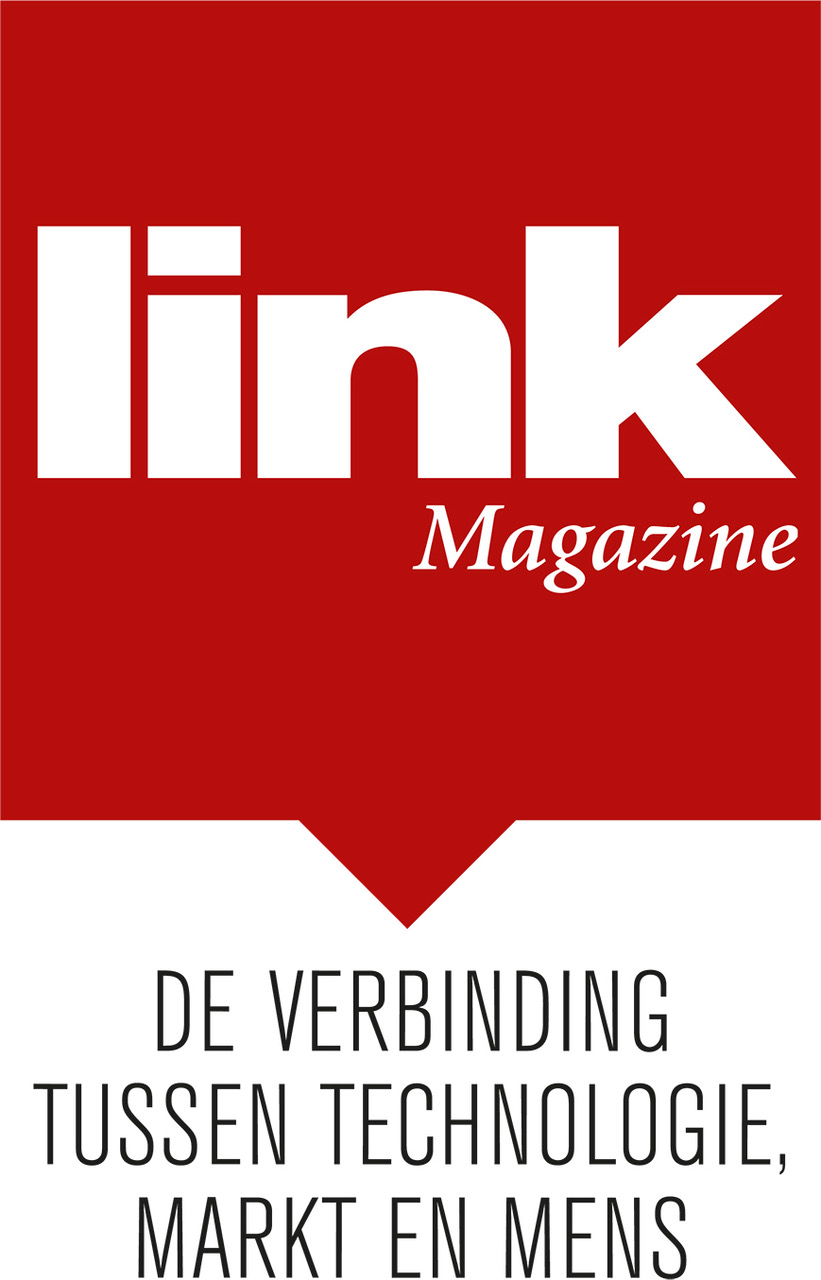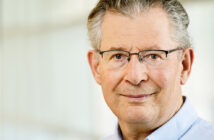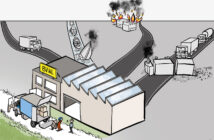The semiconductor industry is in the midst of a three-year ‘supercycle’, with expenditure on high-tech equipment growing 12 to 16 per cent year on year. How do OEMs and Dutch system suppliers manage that growth? What is the optimal collaboration model for this? How do they best allocate their competencies across the world? At the end of March, these questions were the central topics of an online round table with representatives of the Dutch high-tech ecosystem, organised by Link Magazine in cooperation with guest editor-in-chief Theo Kneepkens of semicon OEM KLA.
High-tech ecosystem deploys its development and production power globally
‘Teams’ players
Participants in the online round-table Teams session:
- Tjarko Bouman, CEO at NTS;
As a first-tier system supplier, NTS, headquartered in Eindhoven (NL), develops, produces, assembles and tests complex (opto-)mechatronic systems and mechanical modules. - Jadranko Dovic, Managing Director at VDL ETG Singapore;
As a subsidiary of system supplier VDL ETG, headquartered in Eindhoven and part of the Dutch industrial conglomerate VDL Groep, VDL ETG Singapore supplies parts, modules and systems to most semiconductor OEMs and first-tier suppliers. - Henk Jan Jonge Poerink, Senior Vice President Global Operations at Besi and Managing Director at Besi APac in Kuala Lumpur (Malaysia);
BE Semiconductor Industries (Besi), headquartered in Duiven (NL), is a leading supplier of semiconductor assembly equipment. - Theo Kneepkens, Senior Vice President Global Operations at KLA in Singapore;
KLA is a global OEM, headquartered in Silicon Valley (USA), providing advanced process control and process-enabling solutions to the semiconductor and electronics industry. - Frans van Lierop, Senior Vice President Sourcing & Supply Chain at ASML;
ASML, headquartered in Veldhoven (NL), is the world-market leader in lithography and wafer metrology solutions. - Sven Pekelder, CTO at Settels Savenije group of companies;
Settels in Eindhoven (NL) is a total solution provider to the high-tech industry, covering R&D, development and production of advanced systems, and manufacture of precision parts. - Eric Tielemans, managing director at Demcon advanced mechatronics (DAM) in Best (NL);
DAM is part of the Demcon group, headquartered in Enschede (NL), which develops, produces and supplies technology and innovative products. - Martin van Zaalen, Chief Editor at Link Magazine (moderator).

Henk Jan Jonge Poerink from back-end semicon OEM Besi
The semiconductor industry is entering a supercycle of several years, says Theo Kneepkens, kicking off the discussion. ‘I wonder how suppliers respond to this.’ At system supplier VDL ETG Singapore there is a ‘can do’ mentality, Jadranko Dovic reacts. ‘In the previous semicon’s growth cycle, four years ago, I could agree a multi-million investment plan with the VDL family, which has been implemented and is currently fully utilised. We want to achieve double-digit growth through investments in machines and buildings.’
Growth and shortages

Theo Kneepkens senior vice president of Global Operations at KLA in Singapore. Photo: Darren Francis
The other system suppliers at the virtual round table are also investing heavily. First-tier suppliers are ready to absorb the growth, Kneepkens concludes. ‘Machines and facilities such as cleanrooms are sufficiently available, but I foresee a shortage of components such as linear guides, bearings and chips. How do we prevent second- and third-tier suppliers from causing unpleasant surprises in the supply chain and halting our shipments?’ Henk Jan Jonge Poerink from back-end semicon OEM Besi has the same concerns. ‘For the coming years, shortages of commodities such as chips will be the new trend.’ How can the chain better prepare for this, asks moderator Martin van Zaalen of Link Magazine. Jonge Poerink pleads for more integrated forecasting. ‘Each OEM does this in its own way towards its suppliers, but it is still mainly just sending lists. With an integrated system, it should be easier, especially with multi-tier management, to check whether sufficient demand has been announced to the component suppliers. We don’t have that insight yet.’
With an integrated system, it should be easier, especially with multi-tier management, to check whether sufficient demand has been announced to the component suppliers. We don’t have that insight yet.’

Tjarko Bouman of system supplier NTS
Growth is not only about expanding capacity, but also about making optimal use of the existing capacity in the supply chain, says Tjarko Bouman of system supplier NTS. ‘With scarce resources in the chain, you have to work well together to prevent waste of components and capacity. Can we learn from sectors such as automotive and retail, which have a fully integrated chain? If you combine integrated forecasting for more transparency in the chain, with investments, you’ll have the best of both worlds for the coming years of substantial growth.’
Cut up the chain?
The question is where the investment risk will lie and how reliable agreements and predictions are, says Sven Pekelder of total solution provider Settels Savenije. ‘A forecast is great, but if you expect suppliers to make certain investments and commitments to follow them, then in my view a broader cooperation is part of this. In the automotive industry, outsourcing takes place at a much higher level and suppliers are involved with a complete automobile platform, which gives them a proper understanding of how to set up and manage their own supply chain. The semicon industry isn’t that mature yet, and the question is whether suppliers are ready for the ramp-up. Are they able to collaborate with more parties to make better use of the existing capacity? Could it be an idea to cut the chain into smaller pieces? In recent years there has been an enormous boost among large system suppliers to become even bigger, to be able to supply larger modules in an integrated fashion. I wonder whether that has benefited flexibility.’ Right now, Kneepkens especially wants to warn against reticence when it comes to investments. ‘I’m worried about a shortage of capacity.’ That doesn’t fall on deaf ears, not even with Settels. Pekelder: ‘We have already invested a lot, in production floor space and extra cleanrooms. My concern is that larger first-tier players create greater bullwhip effects further down the chain. Cutting up the chain is then part of the solution to dampen the fluctuations in the forecasts. We’re not so much waiting for purchase orders, although they are always welcome, but for the right discussion, about mutual expectations and about our problems. These may lie in communication, but we all speak Dutch, or in technology, but that’s what we enjoy doing, and in logistics. The parts being around, but not in the right place where they are needed; that’s the biggest challenge in the current growth cycle.’

Sven Pekelder of total solution provider Settels Savenije
Creating leverage
The global growth of the semiconductor industry translates for ASML into pressure on both production and development. Frans van Lierop sees the shortage of components as a temporary problem. ‘But we are now working on massive innovation for our latest technology, high-NA EUV (high numerical aperture extreme ultraviolet, ed.) lithography, also at our partners and that is tensive. Our suppliers are growing fast, in several ways. Here in the Netherlands, of course, but we think it is important that they also do development at other locations, according to a kind of waterfall model, such as VDL ETG does.’ The idea of dividing large modules into smaller modules and sub-modules to improve growth control makes Van Lierop uncomfortable. ‘That will make our lives more difficult, because then we have to coordinate many more little things. We believe in high-level qualified buys.’ Pekelder understands: ‘I am not in favour of ASML splitting 100 modules into 1,000 smaller modules, because they cannot manage that. But there is a coordination burden that we have to manage as a chain. Suppose a component occurs in four modules, of which 100 each have to be produced. Then the supplier will receive four times the demand for 100 pieces for the component in question. If you’re not careful, he might think it’s the same demand every time, so he’ll reserve 100 pieces and the chain will fall short of 300.’ Dovic understands the concerns, but does not see the solution in lower-level outsourcing. ‘We need a more integrated approach. Our high-mix, low-volume, high-tech industry has to compete for scarce components with other industries approaching suppliers for much larger numbers. So, we can only create leverage if we together ‘attack’ those suppliers with a good forecast, in order to obtain a better negotiating position, which will benefit all of us.’
Suppleness
Bouman: ‘In the automotive industry, the greater degree of chain integration ensures greater visibility of future demand and hence a shorter response time. But in that sector, too, they don’t work with three-year commitments. In the corona crisis, you could see the entire industry going down with declining demand for cars; flexibility is greater there.’ But perhaps the organisational setup of the automotive industry is too lean, says Kneepkens, putting this into perspective. ‘Now that demand is rising again, the forecast is immediately corrected, but the delivery times are so long that major problems arise.’ Bouman: ‘What the automotive offers us is not the only solution, but the high-tech must provide more transparency to ensure that the chain can operate more flexibly. By sharing forecasts in the chain, you can achieve more efficiency, minimising the risk of capacity loss and optimising availability. Otherwise, further down the chain, at tier 3 and 4, you’ll end up with uncontrollable bullwhip effects on demand. You have to combine that transparency with the strength of cooperation towards customers.’ Kneepkens: ‘There are all kinds of supplier collaboration models for OEMs, but suppliers must show the willingness to work together, while being each other’s competitors. That is possible, because the growth is so great that there’s enough work for everyone. The only question is how you can optimise that cooperation.’ Pekelder: ‘At least among OEMs, there should be more awareness about how intertwined our supply network is. We have to tell each other better how that network works and how we can manage it, in order to be able to fulfil our growth challenge. I think we can really do that, with suppleness, but what I sometimes experience is that the big boys only ask for more, more, more, on strength and sometimes lose sight of the flexibility in their hinterland.’

Eric Tielemans of high-end technology supplier Demcon
Trust
Then there still is the problem of the change process in engineering that plays a role in forecasting, adds Eric Tielemans of high-end technology supplier Demcon. ‘If changes are underway that have not yet been incorporated in the forecast, the transparency ends. In that case, you could have ordered the chips for a particular module that suddenly turns out to be obsolete. You have to keep close to each other, build a network, continually share information with all parties involved, including your own suppliers. When there is mutual trust, suppliers are willing to reserve components for us, enabling them to react quickly. And of course, you have to take risks yourself. Demcon has decided to expand its high-end production in Enschede and, if required, in the long term we may also want to stick our neck out for a factory of our own in a lower-cost region, for products that are mature.’ Of course, VDL also talks with the customers about customer commitment, Dovic adds. ‘But the bottom line there is mostly no hard purchase orders for justifying generic investments like milling machines. Ultimately, we invest with both feet on the ground and on the basis of trust and understanding the market.’ That trust is abundant in the greater Eindhoven ecosystem, Tielemans agrees. ‘But further down the chain you have to deal with large international component suppliers. Then you enter a different playing field, with a different culture and different behaviour. Our “trust game” is much more difficult to play with this kind of suppliers.’ Collaboration is important and it helps if the partners already know each other, says Van Lierop of ASML. ‘Then you automatically get more certainty as to whether they can turn their “great stories” into orders.’

Frans van Lierop, Senior Vice President Sourcing & Supply Chain at ASML
Sharing risks
Can OEMs take over parts of the risk that system suppliers run with investments based on those great stories, Van Zaalen wants to know. That is already happening, says Van Lierop. ‘There are models for that. Obviously, everyone is looking for a healthy spread of risks and securities. Just as we talk to our customers about long-term large investments, we also enter into discussions with our suppliers.’ With standard investments in new machines or expansion of cleanrooms, for example, Kneepkens thinks it is logical that suppliers take their own responsibility. ‘But the more unique an investment related to a particular customer and the greater the risks, the greater the need to talk about models in which risks are shared.’ Risk sharing starts with sharing information, Pekelder emphasises once again. ‘OEMs can, for example, share their technology roadmap more with suppliers, tell them what their vision is and what role they envisage for parties such as VDL, Settels, NTS and Demcon.’ Eric Tielemans is of course also happy to see that commitment. ‘But it must be on a case-by-case basis, because Demcon must remain our own enterprise. So, the OEMs are willing to invest in the supply chain, but does that also happen from the first tier to the second tier?’ VDL ETG is prepared to act as an intermediary for second-tier suppliers seeking support from an OEM for customer-specific investments, Dovic confirms. ‘There must be a good balance, between generic investments for your own account and very specific, large investments that require a certain degree of order commitment.’ Such second-tier management is crucial in the mechatronics chain where first tiers purchase the majority of their parts, according to Van Lierop.
Next flavour of cooperation
It helps when OEMs have roadmap discussions with first- and second-tier suppliers, to help them prepare for the demand to come, Van Zaalen concludes. ‘They don’t have to open their wallet themselves, unless it concerns highly customer-specific investments by their suppliers.’ That is correct, as long as there is a reasonable balance between investment risk and growth opportunities, says Kneepkens. ‘At ASML, the investment was so substantial in two cases that this OEM decided to do it themselves by taking over the relevant supplier.’ He is referring to the American Cymer, which is building the EUV source for ASML, and Berliner Glas, a renowned German supplier of key optical components and systems. To steer clear of sensitive information, Van Lierop of the listed ASML only wants to respond in general terms. ‘We sometimes use unique competencies of partners. If the demand for this is largely driven by ASML and involves substantial investments, we may consider partnering with such a party permanently (through a takeover, ed.).’ That is an extreme case, however, says Kneepkens of fellow OEM KLA. ‘It doesn’t apply to the parties here at the table. We as OEMs prefer to have strong suppliers who invest themselves instead of us having to do so.’ Van Lierop: ‘We have very intensive partnerships. The next flavour of cooperation would be acquisition, but there are plenty of other ways to warrant investment and assurance.’

Jadranko Dovic, Managing Director at VDL ETG Singapore
Dutch cooperation culture
Interesting industry issues, so Jadranko Dovic of VDL ETG thinks, but he would like to highlight once again the Dutch high-tech ecosystem, which has its focal points in the south and east of the Netherlands. ‘It is unique on a mechatronic level, especially in the philosophy of collaboration. This has been embedded in higher education and training courses for decades and cannot simply be built up somewhere else, for example in China. We can all get even more out of it if we work together more closely and try to find customers together.’ Dovic illustrates this with an anecdote about how he managed to bring in a large American customer more than ten years ago together with Sven Pekelder of Settels Savenije. ‘We saw an opportunity and took it up by stepping out of the shadows; now it is a multi-million programme. For example, Settels, more than VDL ETG at the time, had the development competencies for vacuum systems. In our first meeting with the customer, we talked about our philosophy of mechatronic design, for example thinking in degrees of freedom, and of working with partners for specific technology such as vacuum or sensor technology. That appealed to the customer and that’s how we got the ball rolling.’ Pekelder: ‘We really want to understand and unravel a design problem. We then investigate how we can best divide the “pain” among the various parties, sometimes also outside our own organisation. It is one of the things that makes our Dutch approach unique. Not: I have a problem and I need to fix it. But: There is a problem and who can best solve it? ASML is a very good example. They have invited all kinds of parties from the region to each solve part of their big design problem. We may still advertise too little that OEMs can confidently entrust their design problems to our region.’ ASML would never have been so successful without the ecosystem, Van Zaalen concludes. Van Lierop: ‘Theo already talked about the willingness to work together; I’d rather call it the need to work together. There are so many things that ASML is not the best at, so we gather companies around us in the ecosystem. We really want to do a few things ourselves, such as system design and integration, and we leave a lot of things to partners for good reasons. Eighty percent of our added value comes from outside.’

Martin van Zaalen, Chief Editor at Link Magazine (moderator).
Dutch approach uniqu: There is a problem and who can best solve it?

Theo Kneepkens (KLA) about supercycle of growth: Í hope that supply industry expands its capacity’. Read this edition of link magazine digitally via this link
Continent-to-continent copy
Can the Dutch cooperation culture be copied ‘local for local’ to the various continents and should the semicon industry be organised per continent, just like the automotive supply chains, Van Zaalen wants to know. ‘We do not find medium-sized mechatronics companies in the Beijing yellow pages,’ says Van Lierop. ‘We already know them from the south of the Netherlands, so we are going to talk to them about cooperation on other continents.’ For production, those supply chains are already available per continent, says Theo Kneepkens. ‘I wonder whether it is also necessary for development and the real top competencies. Our world and our volumes are perhaps too small for that. Our suppliers have one location where they really build up their knowledge and do their high-end development.’ Location is just one aspect, Van Lierop continues. ‘Of course, we first look at the competencies; a party must be able to do what we ask for in terms of technology development. When it comes to mechatronics and electronics competencies, we are blessed in the south of the Netherlands. If something is knowledge-intensive, we naturally want to work on it closely together. Other considerations come later, such as cost leadership and ‘local for local’ for service business. So, it is important that our partners themselves invest in global expansion and believe in it.’ Kneepkens: ‘In the Netherlands, more than in some other cultures, I see the willingness to cooperate and to expand globally. Numerous Dutch system suppliers have set up branches elsewhere in the world to develop together close to the customer or to do production in lower-cost countries. That is a unique combination.’ Can we also spread this open collaboration mentality around the world, Van Zaalen asks. Eric Tielemans does indeed see more openness emerging in certain countries. ‘For example in Japan, where the older generation is traditionally rather formal, while the younger generation is already more involved in our open way of thinking and working.’ Then the Netherlands will lose its advantage if the rest of the world copies our approach, Kneepkens responds tongue in cheek.

Marc Hendrikse. Foto: Holland Hightech
Next generation
All technological competencies represented at the table, from motion to vacuum, largely originate from the (former) electronics superpower Philips. ASML and VDL ETG, for example, (partly) originated from Philips. Although all players are currently fully occupied with the growth in the semiconductor industry, there are opportunities to use all those competencies even more for other markets. Sven Pekelder mentions flat-panel displays as an example and Eric Tielemans responds to this. ‘We could work together as a region to build equipment for different display techniques. The factories will be located in Asia, but we can supply the equipment for them from the south of the Netherlands; we have the competencies and the culture of cooperation for this.’ It is exactly what the investment programme NXTGEN HIGHTECH, led by former NTS CEO Marc Hendrikse, is aiming at, moderator Martin van Zaalen notes to conclude the round-table. ‘That programme is intended to apply the technology that the Netherlands is now so successful with in semiconductor and in other areas as well. NXTGEN wants to apply to the Dutch national Growth Fund for this.’ In short, the growth perspective for the Dutch high-tech ecosystem is only getting wider.






